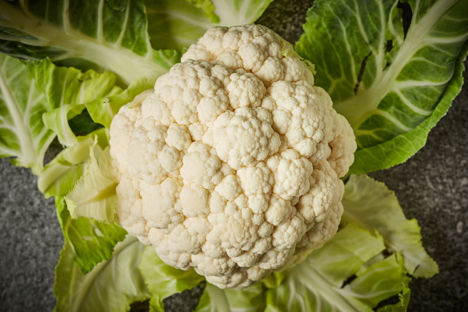Cauliflower is a brassica or cruciferous vegetable – also known as the cabbage or mustard family – joining the likes of broccoli, Brussels sprouts, kale and (unsurprisingly) cabbage and mustard greens. It is packed with vitamins B and C and high in fibre. Most of the UK’s cauliflowers are grown in Lincolnshire and whilst it is harvested in spring and autumn it is generally available year-round. While you’ll be most familiar with a white cauliflower, heritage purple and orange varieties are now available along with the magnificent bright green and geometric looking romanesco cauliflower.
What to look for when buying cauliflower
A cauliflower’s outer leaves provide natural protection for the white florets (or 'curds', as they are sometimes known). Look for heads with firm, white florets without blemishes – if they do have the odd black or brown patch, simply cut these off and discard (the rest of the vegetable should be fine). The leaves are a great indicator of the vegetable's health; ideally they should be firm and vibrant green with no yellow or black spots. If the leaves and stalks (or ‘ribs’) are healthy, avoid wasting them – they can be shredded and stir-fried, simmered in stocks or roasted with the rest of the vegetable.
How to boil cauliflower
Like all vegetables, cauliflower retains the most of its nutrients when eaten raw or lightly steamed or boiled. Here is a quick and simple method to boil it.
Metric
Imperial
- 1 cauliflower
- 1 knob of butter
- chopped flat-leaf parsley, chives, or dill
- salt
- freshly ground black pepper
Remove the leaves and trim down the stalk at the bottom. You can reserve the leaves for stock or another dish, but here we're only interested in the florets and stalk. Cut the head into florets all roughly the same size, then dice the stalk into 2cm pieces
Place a large pan of salted water over the heat and bring to the boil. Once boiling, add the cauliflower and boil for 5-7 minutes or until the cauliflower can be easily pierced with a knife
Drain then toss with a knob of butter, plenty of salt and pepper and some chopped herbs. Transfer to a serving dish and serve hot
How to roast cauliflower
Roast cauliflower is a fuss-free way of cooking the vegetable and can easily be marinated in a variety of herbs, spices and seasonings to provide extra flavour. Here is a simple recipe to roast it as a side dish. You can switch up the spices if you fancy – a sprinkle of turmeric, chilli flakes or smoked paprika all work wonders.
Metric
Imperial
- 1 cauliflower
- 1 tsp cumin seeds
- olive oil
- salt
- freshly ground black pepper
Preheat an oven to 200ºC/gas mark 5
Remove the outer leaves of the cauliflower and wash them. Cut the head of the cauliflower into florets, halving any of the larger ones so they are all roughly the same size. Slice the leftover stalk and chop into roughly 2cm pieces
Place the florets and stalk into a roasting tray and toss with a good drizzle of olive oil and a sprinkle of cumin seeds. Roast in the oven for 15-20 minutes
Lightly toss the washed leaves in olive oil then add to the tray after 15-20 minutes or once the cauliflower is soft and starting to brown. Roast for 5 more minutes to crisp up the leaves then serve hot
Cauliflower flavour pairings
Cauliflower cheese evolved
Cauliflower does the classics
Cauliflower and scallops
Whole roast cauliflower
Plant-based cauliflower recipes
Cauliflower steaks
Cauliflower as a 'grain'
Spiced cauliflower
All kinds of fritters
Hearty salads
Experimental cauliflower
Get in touch
Please sign in or register to send a comment to Great British Chefs.



